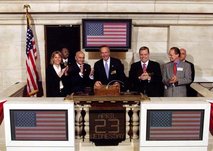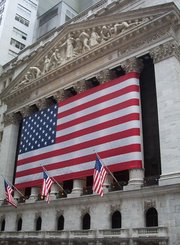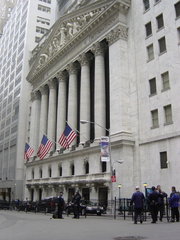New York Stock Exchange
|
|
The New York Stock Exchange (NYSE) is the second largest stock exchange in the world. It was the biggest exchange until 1996 when its trading volume was exceeded by that of NASDAQ (historic comparison graph) (http://schwert.ssb.rochester.edu/f434/f434nasd.pdf). The NYSE is now a for-profit business now that it and the fully electronic stock exchange Archipelago merged in late April 2005. New York Stock Exchange, Inc, with its main building located at 18 Broad Street, at the corner of Wall Street, on the south side of Wall Street, in New York City, New York, U.S.A.
| Contents |
Quick facts
NYSE is home to some 2,800 companies valued at nearly $20 trillion in global market capitalization. As of July 2004, all but two of the thirty companies in the Dow Jones Industrial Average were listed on the NYSE, the exceptions being Intel and Microsoft.
Business
NYSE trades, unlike those on electronic exchanges (e.g. NASDAQ), always involve face-to-face communication in a particular physical location. There is one station at each post on the trading floor for each of the exchange's stocks. Exchange members interested in buying and selling a particular stock on behalf of investors gather around the appropriate post where a specialist broker, who is employed by a NYSE member firm (that is, he/she is not an employee of the New York Stock Exchange), acts as an auctioneer in an open outcry auction market environment to bring buyers and sellers together and to manage the actual auction. They do on occasion facilitate the trades by committing their own capital (approximately 10% of the time) and as a matter of course disseminate information to the crowd that helps to bring buyers and sellers together. Most of the time natural buyers and sellers meet in a market that provides price discovery in an auction environment that produces the fairest price for both parties. The human interaction and expert judgement as to order execution differentiates the NYSE from fully electronic markets. The hybrid market structure is constantly in need of improvement and has trouble keeping up with new innovations in trading technology with too many humans on the floor. The frenzied commotion of men in colored smoks has been captured in several movies, including Wall Street.
History
The origin of the NYSE can be traced to May 17, 1792 when the Buttonwood Agreement was signed by twenty-four stock brokers outside of 68 Wall Street in New York under a buttonwood tree. On March 8, 1817 the organization drafted a constitution and renamed itself the "New York Stock & Exchange Board". This name was shortened to its current form in 1863.

The Exchange was closed shortly after the beginning of World War I (July 1914), but it was re-opened on November 28 of that year in order to help the war effort by trading bonds.
The Black Thursday crash of the Exchange on October 24, 1929 and the sell-off panic which started on Black Tuesday, October 29, precipitated the Great Depression. In an effort to try to restore investor confidence, the Exchange unveiled a fifteen-point program aimed to upgrade protection for the investing public on October 31, 1938.
On October 1, 1934, the exchange was registered as a national securities exchange with the U.S. Securities and Exchange Commission, with a president and a thirty-three member board. On February 18, 1971 the not-for-profit corporation was formed, and the number of board members was reduced to twenty-five.
Following a 554.26 point drop in the Dow Jones Industrial Average (DJIA) on October 27, 1997, officials at the Exchange for the first time invoked the "circuit breaker" rule to stop trading. This was a very controversial move and prompted a quick change in the rule; trading now halts for an hour, two hours, or the rest of the day when the DJIA drops 10, 20, or 30 percent, respectively. In the afternoon, the 10 and 20% drops will halt trading for a shorter period of time, but a 30% drop will always close the exchange for the day. The rationale behind the trading halt was to give investors a chance to cool off and reevaluate their positions.
The first central location of the NYSE was a room rented for $200 a month at 40 Wall Street in 1817.
The NYSE was closed from September 11 until September 17, 2001 as a result of the September 11, 2001 terrorist attacks.
On September 17, 2003, NYSE chairman and chief executive Richard Grasso stepped down as a result of controversy concerning the size of his deferred compensation package. He was replaced as CEO by John Thain, the former President of Goldman Sachs Group Inc.
On April 21, 2005, the NYSE announced its plans to acquire Archipelago, in a deal that brought the NYSE public.
Levels
- Listed companies 2,758 ([1] (http://www.nyse.com/Frameset.html?displayPage=/marketinfo/1022221393893.html))
- Market cap $19.7 trillion ([2] (http://www.nyse.com/Frameset.html?displayPage=/marketinfo/1022963613722.html))
- Members 1,366 ([3] (http://www.nyse.com/about/members/1089312755132.html))
Related articles
- Stock exchange
- List of stock exchanges
- NASDAQ
- American Stock Exchange (AMEX)
- American Stock Markets
- Stock index
- Dow Jones & Company
- Dow Jones Industrial Average
External links
- New York Stock Exchange website (http://www.nyse.com)
Articles
- NYSE to Merge With Electronic Rival Archipelago, Transform Itself Into For-Profit Enterprise (http://biz.yahoo.com/ap/050421/nyse_archipelago.html?.v=6)
- All Business: The conflicted roles in NYSE merger (http://www.post-gazette.com/pg/05122/496749.stm)be:Нью-Ёрцкая Фондавая Біржа
de:New York Stock Exchange es:New York Stock Exchange fr:New York Stock Exchange id:NYSE ja:ニューヨーク証券取引所 nl:New York Stock Exchange pt:New York Stock Exchange zh:纽约证券交易所


